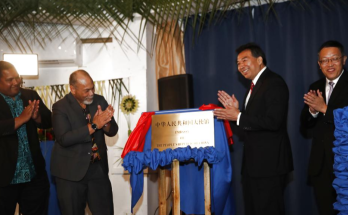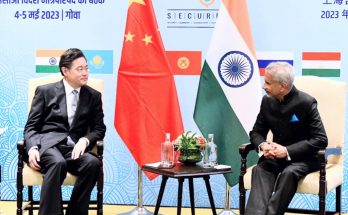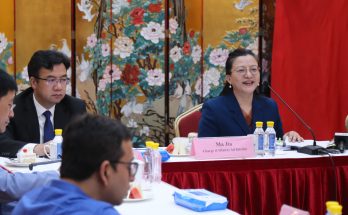 The actions or adventures of China’s People’s Liberation Army just before the visit of Chinese President Xi Jinping to India had grabbed headlines in India, China and many other countries. The intrusion into the Indian territory in the Ladakh region badly affected Mr Xi’s much anticipated and hyped visit. But, why did the PLA do it? Was it done with the knowledge of the President himself?
The actions or adventures of China’s People’s Liberation Army just before the visit of Chinese President Xi Jinping to India had grabbed headlines in India, China and many other countries. The intrusion into the Indian territory in the Ladakh region badly affected Mr Xi’s much anticipated and hyped visit. But, why did the PLA do it? Was it done with the knowledge of the President himself?
To understand this, one needs to know the difference between the PLA and most other Armies in the world. PLA is not an Army of the state of China, but an Army of the Communist Party of China. Hence it owes its allegiance to the Party rather than the ‘state’.
While this may hardly make any difference to the world at large or to its apprehensive neighbours who have been at the receiving end of its current aggressive posturing, but recent indications indicate that the PLA is prone to act on its own and is out of sync with its political masters in the party.
Viewed as somewhat corrupt and self serving — many of the Generals of the Army live like kings and enjoy perks that seem wishful to the common man as well as the politicians. It is probably this aspect that has led Mr Xi to publicly address his unhappiness — a very unusual move which had been resorted to by his predecessor Hu Jintao earlier.
Mr Xi the Chinese President who came calling in India recently, has been considered to be the strongest leader of rising China since Deng Xiaoping. But a spate of events has raised questions as to how powerful is he and if he is really in control of the vast PLA.
 Though opinion is divided, it cannot be logically explained as to why the Chumar standoff in eastern Ladakh started and continued exactly at a time when Mr Xi was on a high profile visit to India. Many argue that it may be due to sheer miscommunication or that it is in the Chinese “nature” to raise “controversial and issues of dispute” prior to any important visit to India. Not unlike their 19-kilometre deep intrusion into the Depsang Valley in 2013 just before the visit of premier Li Keqiang’s to India which took 21 days to sort out.
Though opinion is divided, it cannot be logically explained as to why the Chumar standoff in eastern Ladakh started and continued exactly at a time when Mr Xi was on a high profile visit to India. Many argue that it may be due to sheer miscommunication or that it is in the Chinese “nature” to raise “controversial and issues of dispute” prior to any important visit to India. Not unlike their 19-kilometre deep intrusion into the Depsang Valley in 2013 just before the visit of premier Li Keqiang’s to India which took 21 days to sort out.
However, this time round, things were different with weighty strategic issues at stake. In the background of the successful Indian PM’s visit to Japan, an early outreach towards Mr Modi was seen an essential ingredient in making sure that Delhi does not gravitate rapidly to an emerging anti-China coalition in the Indo-Pacific region with the unfolding of the US policy of strategic rebalance. Thus, reducing the level of existing strategic mistrust between the countries and enhancing commercial ties. Additionally, it was a prized opportunity to build up on personal rapport between the two leaders that had commenced at the earlier meeting at Brazil during BRICS.
Commercially, the success of the visit was open to debate with a signing of 12 MoUs with China willing to invest a toned down $20 billion in India over the next five years. This was in sharp contrast to the statement of the Chinese Consul-General in Mumbai — grandiose statement that must have had the backing of Beijing: “On a conservative estimate, I can say that we will commit investments of over $100 billion or thrice the investments committed by Japan during our President Xi Jinping’s visit next week.”
During the visit, the dark shadow of the Chumar stand-off left a deep negative impact reiterating old notions of distrust and could not have escaped the eyes of the visiting Chinese.
The issue was raised by Mr Modi who called for an early settlement, saying that the “true potential of our relations” would only be realised when there was “peace in our relations and in the borders”. Mr Xi responded positively assuring that “peace and tranquillity” was his commitment. He also stated “…This (border issue) must be settled soon. China is determined to settle the boundary question at an early date.” Though rumours state that he honestly did not know the details of the stand-off. However, despite presidential assurances, the stand-off continued clearly indicating that the PLA troops on ground were totally out of synch with their political masters or probably some elements in the Army had become ‘rogue’ with heady nationalistic fervour as it is inconceivable that their headquarters were not in communication with them or that this was the result of a miscommunication between the leadership in Zhongnanhai and the Field Commanders.
In the recent aftermath Mr Xi stepped in to “rebuke” and take control. Speaking at the PLA headquarters in Beijing with PLA chiefs of staff present he emphasised that the “Headquarters of the PLA forces must have absolute loyalty and firm faith in the Communist Party of China, guarantee a smooth chain of command and make sure all decisions from the central leadership are fully implemented…”
While most foreign China analysts flagged his pronouncements on the likelihood of a regional war, which was later forcefully debunked by the Chinese Foreign Ministry spokeswoman Hua Chunying, in reality the ‘loyalty’ factor was crucial and displayed the attempt to ‘rein in’ the wayward elements.
Later, at that event , General Fang Fenghui, PLA chief, reiterated that all PLA forces must follow the instructions of President Xi the chairman of the CMC, thus indicating that the top brass were in line with the top political leadership.
(The author is a Senior Fellow at Observer Research Foundation)
Courtesy: ORF
Author Profile
- India Writes Network (www.indiawrites.org) is an emerging think tank and a media-publishing company focused on international affairs & the India Story. Centre for Global India Insights is the research arm of India Writes Network. To subscribe to India and the World, write to editor@indiawrites.org. A venture of TGII Media Private Limited, a leading media, publishing and consultancy company, IWN has carved a niche for balanced and exhaustive reporting and analysis of international affairs. Eminent personalities, politicians, diplomats, authors, strategy gurus and news-makers have contributed to India Writes Network, as also “India and the World,” a magazine focused on global affairs.
Latest entries
 DiplomacyApril 10, 2024Diplomat-author Lakshmi Puri pitches for women power at LSR
DiplomacyApril 10, 2024Diplomat-author Lakshmi Puri pitches for women power at LSR India and the WorldApril 6, 2024UN envoy pitches to take India’s solutions to the world stage
India and the WorldApril 6, 2024UN envoy pitches to take India’s solutions to the world stage CultureApril 5, 2024Youth in Diplomacy: Making it Matter with LSR Model UN 2024
CultureApril 5, 2024Youth in Diplomacy: Making it Matter with LSR Model UN 2024 India and the WorldMarch 28, 2024India to China: Normalization of troops deployment imperative for restoring ties
India and the WorldMarch 28, 2024India to China: Normalization of troops deployment imperative for restoring ties







